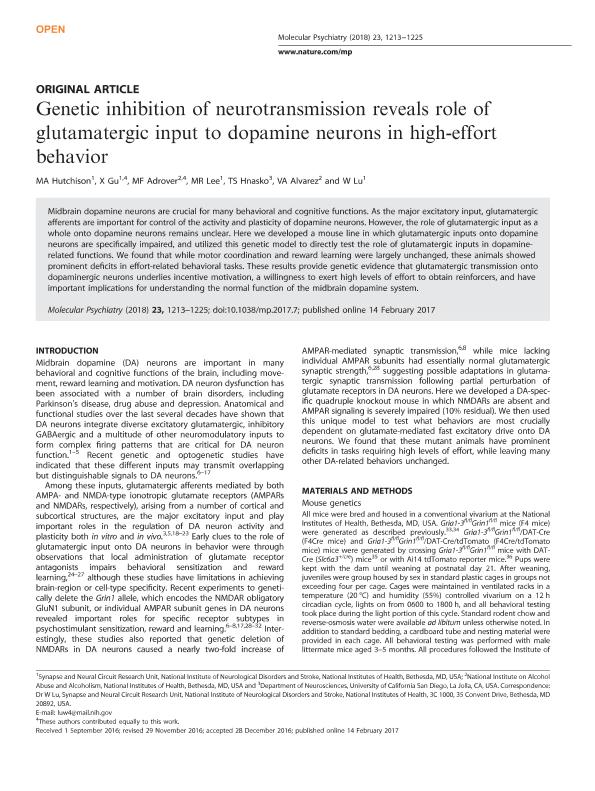Artículo
Genetic inhibition of neurotransmission reveals role of glutamatergic input to dopamine neurons in high-effort behavior
Hutchison, M. A.; Gu, X.; Adrover, Martín Federico ; Lee, M. R.; Hnasko, T. S.; Alvarez, V. A.; Lu, W.
; Lee, M. R.; Hnasko, T. S.; Alvarez, V. A.; Lu, W.
 ; Lee, M. R.; Hnasko, T. S.; Alvarez, V. A.; Lu, W.
; Lee, M. R.; Hnasko, T. S.; Alvarez, V. A.; Lu, W.
Fecha de publicación:
05/2018
Editorial:
Nature Publishing Group
Revista:
Molecular Psychiatry
ISSN:
1359-4184
Idioma:
Inglés
Tipo de recurso:
Artículo publicado
Clasificación temática:
Resumen
Midbrain dopamine neurons are crucial for many behavioral and cognitive functions. As the major excitatory input, glutamatergic afferents are important for control of the activity and plasticity of dopamine neurons. However, the role of glutamatergic input as a whole onto dopamine neurons remains unclear. Here we developed a mouse line in which glutamatergic inputs onto dopamine neurons are specifically impaired, and utilized this genetic model to directly test the role of glutamatergic inputs in dopamine-related functions. We found that while motor coordination and reward learning were largely unchanged, these animals showed prominent deficits in effort-related behavioral tasks. These results provide genetic evidence that glutamatergic transmission onto dopaminergic neurons underlies incentive motivation, a willingness to exert high levels of effort to obtain reinforcers, and have important implications for understanding the normal function of the midbrain dopamine system.
Palabras clave:
Midbrain
,
Dopamine Neurons
,
Glutamate Receptors
,
Behavior
Archivos asociados
Licencia
Identificadores
Colecciones
Articulos(INGEBI)
Articulos de INST.DE INVEST.EN ING.GENETICA Y BIOL.MOLECULAR "DR. HECTOR N TORRES"
Articulos de INST.DE INVEST.EN ING.GENETICA Y BIOL.MOLECULAR "DR. HECTOR N TORRES"
Citación
Hutchison, M. A.; Gu, X.; Adrover, Martín Federico; Lee, M. R.; Hnasko, T. S.; et al.; Genetic inhibition of neurotransmission reveals role of glutamatergic input to dopamine neurons in high-effort behavior; Nature Publishing Group; Molecular Psychiatry; 23; 5; 5-2018; 1213-1225
Compartir
Altmétricas



